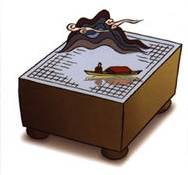"First Kyu" by Sung-Hwa Hong
I had heard a lot about this book, and finally bought it. When my package from Amazon arrived and I opened it, I first thought they forgot to put the book in, then I saw something like a CD envelope and thought they sent something else by mistake.
It's a very small book, size-wise, but don't let that mislead you: this is a wonderful novel about youth, love, Go, friendship, sacrifice.
The story covers a few years in the life of a teenager in Korea of late 60's and early 70's who decided to become a professional Go player.
The title may be confusing for today's amateur ranking system; in those times, "first kyu" was meant to designate a top amateur player. The book also mentions dan amateur ranks, but they seem to have been associated with payed diplomas that the Korean Baduk Association would sell for a profit, regardless of the individual's actual strength.
Initially I thought that the book is about insei in Korea (in Korean, the term for insei is "wonseng", or "yeongusaeng" - depending on the transliteration, I guess). But I was wrong, the story is about the non-insei category of people competing to become a professional. Nowadays, in Japan at least, each year's professional pre-qualification tournament has one place open to the public (amateurs can qualify through a separate tournament). The system that the book describes was a very open one, where about 300 players (both insei and amateurs) would compete altogether, twice a year, for top 2 places to become professional Go players.
The novel does such a great job describing the dedication and despair of people who want to make pro:
Actually this is true not only for people wanting to become pro, but for all of us Go players: who hasn't felt betrayed by Go at one time or another?
We also find very good advice for studying Go in the novel:
There is a whole chapter describing the "blood-vomiting game" between Intetsu and Honinbo Jowa so nicely that it made me wanting to replay that game immediately:
On replaying masters' games:
On playing naturally, a Chinese scholar's saying, often quoted later by Takagawa Honinbo, appears several times in the book:
The illustrations are very nice too - I like best the one the cover:

The novel also touches a lot on bangneki - some sort of "gambling Go", where the amount of monetary gain is determined by the point difference in the end of the game. It seems to have been the main source of income for some top amateur players at that time. It is still very popular in Korean amateur clubs nowadays as well.
Here is the list of all chapter names:
- Before We Begin
- Old Master
- The Hustler
- A Stone Thrown Into a Calm Lake
- First Kyu
- Dong
- New Friends
- Inae Park
- Nak
- The Blood Coughing Game
- The Road to Go
- The Professional Qualifying Tournament
- Bangneki
- Lost Friends
- The Seoul Club
- The Runaway
- New Life
- The Second Teacher
- Mr. Chang
- Play Inside First Before Any Other Move
- Greed For a Win Takes the Win Away
- Ko Fights
- Slow Down, Beware of Speed
- Give Up a Little to Gain Big
- Be On Your Guard Among Enemies
- Utmost Caution in Enemy Territory
- Second Counting
- Flowing Water Do Not Compete to Be First
- Five-Petalled Flower
- Choking Move
This is a great book about Go, and I believe it is general enough to be attractive to non Go players as well. Tragically, the author died in 2001, at the age of 51.
